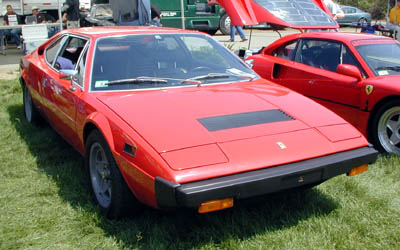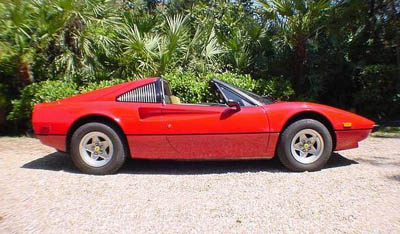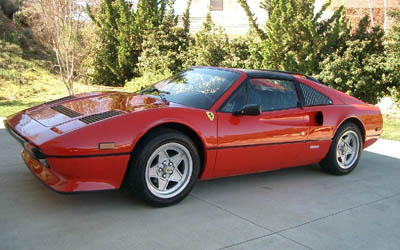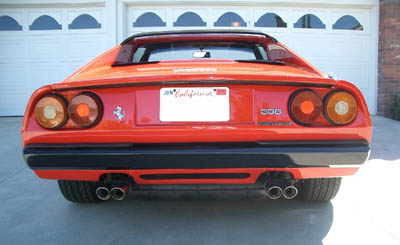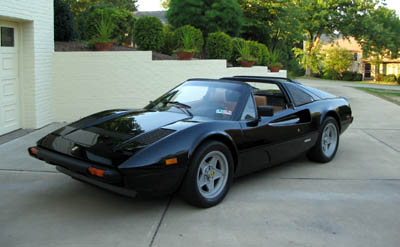
|
|
|
|
|
|
|
The Ferrari 308: A Buyer's Guide © 2006 Jonathan Bird The Ferrari 308, known by many for its role as co-star to Tom Selleck in the hit TV series "Magnum P.I." is one of the most recognizable cars in the world. It is almost certainly the most recognizable Ferrari ever made, and highly sought after, especially by people like me who grew up watching Magnum, and hoping to one day own the sexiest car in the world. The 308, with its mid-engined layout, low roofline, and exotic sounding 3 liter V-8 is in every sense of the word an exotic car. Made by hand in Italy by the most famous sports car company in the world, the 308 is drop dead beautiful, even more so in person than in pictures. (Pictures never seem to convey how low this car is, which makes it look so much more amazing in person). The 308 was made for a long time, spanning 10 years from its introduction in 1975 to the last year of production, 1985. In 1986 the 308 was replaced by the very similar looking 328, with a 3.2 liter engine, 20 more horsepower, and color-coded bumpers painted the same color as the car, rather than black like the 308. (They ruined the lines of the 308 in my opinion, but that's a personal taste!) While it is often written that the 308 GTB/GTS evolved from the Dino 308 GT4 that came before it, this is only partly true. The whole story requires a bit more history. In 1967 Ferrari introduced a lower-cost line of cars called "Dino" named after Enzo Ferrari's beloved son Dino who died at a young age from muscular dystrophy. This less-expensive Ferrari was often called the "baby" Ferrari. Like the modern Scion brand made by Toyota and aimed at a less affluent buyer, the Dino was still made by Ferrari, with the construction of the Ferrari-designed engines farmed out to Fiat. To make production costs lower, Fiat shared the use of the engine in their Fiat Dino, a front engined car that looked nothing like the Ferrari Dino. The first road-going Ferrari Dino, the 206 GT, was a very sexy, curvy shape typical of the flowing curves of 1960's sports cars, but unique. Designed by the Italian company that designed most of Ferrari's cars (Pininfarina) the 206 was at the time (and still is) considered one of the most gorgeous car designs of all time. It had a 2 liter V-6 engine (mid-mounted). By 1970, this car evolved into the 246 Dino, with a slightly larger engine (2.4 liters) but looking pretty much the same as the 206. By 1974, the next Dino to be introduced was the Dino 308 GT4, (Gran Tourismo 4-cam). It had a 2+2 layout, with a 3 liter V-8 mid-engine. The small V-6 of the previous Dino was not powerful enough for this heavier, 4 passenger car. So Ferrari developed an entirely new engine for the GT4. It was the first V-8 that Ferrari ever put in a road car, and a fantastic little engine. This time, the whole engine and car were made entirely by Ferrari. The engine no longer said Dino on it. It said Ferrari. But the badge on the tail was not a Prancing Horse--this was still a Dino. Because this was a mid-engined car with back seats, it had very limited back seat space. Many contend that the back seats are useless for actual people, although they're not bad for cargo. But the 308 GT4 handled like a dream and was popular as a car for racers who wanted to race a "budget" Ferrari. (The GT4 was less expensive than "true" Ferraris, but it was still not a cheap car by any stretch.) The big problem with this car was the "wedgy" design by Bertone. Bertone is best known as the company that designed many of Lamborghini's cars, including the distinctive Countach. The similarities in wedge shape between the Dino 308 GT4 and the Countach are obvious. But this shape did not sell well for Ferrari. The GT4 was a tremendous sales disappointment for the company. It was a bit strange looking in many people's eyes, and it did not say Ferrari on the back either. By mid-1975, dealers were directed by Ferrari to add Ferrari badges to the GT4 inventory to help sales. Today you see many GT4s that say both Ferrari and Dino on them for this reason. In 1975 a new Ferrari 308 was announced. It was not to be badged a Dino. In fact, the Dino line of cars was considered a failure and no more Dinos were on the drawing board. This new car was a bit confusing to the public. It had the name 308, but didn't look anything like the 308 GT4. It only had two seats. It was an evolution of the 246 GT Dino in appearance, but had the engine from the 308 GT4. Although the 308 GTB had a little bit of wedge shape, it still retained much of the curved lines of the Dino 246. It was the perfect blend of curve and wedge. When it was announced and shown to the public, jaws dropped. The new Ferrari was an instant hit. But the little 2.4 liter V-6 powerplant from the Dino 246 would not be enough engine for this 3,000+ pound car. Instead, Ferrari lifted the engine right out of the Dino 308 GT4 and dropped it into the GTB. With 4 Weber dual-throat downdraft carburetors and a uniquely Ferrari exhaust system, this car roared like a lion and made a claimed 255 HP at the crankshaft. (Please keep in mind that Ferrari is known to have been very optimistic in the rating of their engines). The first production GTB rolled off the assembly line in 1976. It had a body made of fiberglass (like a Corvette) because Ferrari had no idea if they would sell enough to start a massive manufacturing campaign in steel. So they tested the waters with fiberglass which could be made more cost-effectively in small numbers. The instant success of the GTB meant that they started tooling up to build the car out of steel like all other Ferraris almost immediately. By mid-1977 the GTB was being made in steel. They didn't just switch over to steel however. Demand for the car was so great that Ferrari continued to turn out fiberglass cars for another year while they were also building steel cars. The fiberglass cars are the rarest and demand the most money now. It is interesting to note that Ferrari continued to sell the 308 GT4 until 1980, right alongside the newer 308 GTB. The GT4 was now called a Ferrari and badged that way from the factory. Gone was the name Dino. Sales improved, but the looks still made the car a slow seller. The relative rarity of the GT4 has made it a bit of a cult classic these days with a devout following. (Good examples are getting hard to come by "cheap" anymore.) It is also quite striking to see in person. The GT4 does not photograph nearly as well as it looks "in the metal." The GT4 was eventually replaced with the Mondial, the next 2+2 V-8 in the Ferrari line-up. While many people say that the GTB evolved from the GT4, this is simply not true. The GTB has much more in common with the 246 Dino in terms of shape, and being a 2 passenger sports car. The only thing it got from the GT4 was the engine/transmission and some other mechanical bits like brakes. The GTB and the GT4 were produced and sold along side each other for 5 years. There were small differences between the GTBs designed for the European market versus the American market. The U.S. had stricter emissions standards, as well as stricter crash safety standards, so the cars that came to the U.S. were de-tuned a bit to improve emissions, and had some more weight in the form of better bumpers (yes, they are heavier, but as bumpers they are better) and reinforcements in the doors and front frame. They also had air pumps in the engine bay to pump air into the exhaust manifolds. This helps burn off excess hydrocarbon emissions before they are released into the atmosphere. The Euro cars had a single distributor, while the American cars had twin distributors so that a second set of points could be used to retard timing at idle for lower emissions. As well, many of the Euro cars had a dry-sump engine, better for racing when the engine would be subject to a lot of lateral forces in extended cornering. The U.S. market cars were rated at 240 HP while the Euro cars were rated at 255. In 1977 Ferrari also announced the GTS ("spyder") version of the 308, with a removable roof panel, like the Targa top on a Porsche. It was remarkably easy to remove and replace, and stowed behind the seats when removed. Although the GTS chassis was not as rigid as the amazingly stiff GTB, the open-air driving was desired by many buyers and more than made up for the small amount of flex introduced by the loss of the roof. In 1978 when the GTS finally became available to buyers, it outsold the GTB by a factor of 2 to 1, making the GTB a rarer car these days, though the GTS continues to be more desirable than the GTB for the open-top experience of driving it. 1978 was also the year when U.S.-bound 308's came equipped with catalytic converters, to meet ever-stricter emissions standards. The 1978 and 1979 308s had leaner jetting for emissions and lower lift and duration cams, to keep the emissions down. Ferrari now claimed this U.S. version was making only 205 HP. This sounds terrible now, but a look at other performance cars of the "smog era" will show that these were impressively powerful cars in the late '70s. In mid-1980, Ferrari made the leap to Bosch K-Jetronic mechanical fuel injection and this helped them continue to meet the U.S. emissions standards, getting tougher every year. Clearly, Enzo Ferrari did not want to go this route as the race cars of the day retained carburetors. This change had several resulting effects to the 308. For one, it lost the intoxicating intake howl of the Webers, something that is one of the most wonderful sounds in the history of cars (but I'm not biased or anything). One positive change was no longer needing to keep a bank of touchy Webers in tune. The Bosch K-Jet improved reliability, especially cold starting, which can be tricky with carburetors. General drivability improved as the K-Jet does not exhibit some of the quirks of carbs such as fuel starvation in turns and hesitation or "flat spots" at some throttle openings. The addition of electronic ignition made points a thing of the past, though the car still used distributors/rotors to distribute the spark. Along with the switch to injection came the switch to Michelin TRX ("metric") tires on a special 390 mm wheel. These were a tad larger than the 14" wheels of the 1976-1979 cars. The TRX tires were at the time a great improvement in tire technology. But now, 25 years later, TRX tires are no longer popular and you can only get them from Michelin by special order, and they are about three times the cost of modern tires (over $400 per tire). Modern tire technology is vastly superior. The only person that wants TRX tires on a Ferrari these days is the person interested in originality. Everyone else changes over to 16" or larger wheels. With the 308 losing horsepower every year, the car was no longer fast enough for the Ferrari reputation, and something had to be done. In 1983 the engine was slightly redesigned to have four valves per cylinder (instead of the two valve heads on the carb and early injected cars). These new 308s were called Quattrovalvole (pronounced "KWA-tro-val-VOH-lay" meaning "four valve") and abbreviated QV. The U.S. market cars were rated again at 230 HP (Euro was 240) and the 308 had its pep back. Also in 1983, 16" wheels were offered. These "QV" wheels are now the most sought after retrofit for older 308s as the larger wheel looks more modern, and allows fitting of cheaper and more modern, sticky rubber. In 1984, Ferrari finally got with the times and started making the 308 with galvanized steel for better rust-proofing. Earlier cars are known to rust readily. Even though most owners baby them and keep them out of the rain, it is nice to know that the '84 and '85 cars have a bit more protection from the elements. Which to buy? Well, there are many things to consider. The production can be roughly broken down into four main groups of models: 1. Early carb cars (subdivided into fiberglass and steel variants) 1976-1977 2. Later carb cars 1978-1980 3. 2 valve injected cars 1980-1982 4. QV cars 1983-1985 The most desirable 308 is the fiberglass GTB, only because there were less than 1,000 made and it is the rarest. It also has the advantages of the early carb set-up, which was the most powerful and made the best sounds. The fiberglass also makes it the lightest 308 (though not by much to be honest). They are hard to find now. Most are in collections and they have gone up in value in recent years. There are no bargains to be had on these cars anymore! If you want one, you will pay dearly! Expect to pay USD $60K plus*. (My prices are very ballpark based on values at the time of writing this which is 2006). The second most desirable is probably the QV, as it is nearly as powerful as the early carb cars, but has the reliability of the K-jet injection. It also happens to be the newest, though at this point, they are all old cars and age is not as important as how well the car has been cared for. The QV is a solid, reliable car. Plenty were made, and finding a good one is not hard if you look around. Expect to pay around $35K-$45K* for a decent one. Following closely behind the QV in popularity are the early steel carb cars (1977) because of the performance, and sound of the Webers. For a good one, expect to pay $30K-$50K* depending on condition. Next in desirability are the later carb cars (1978-1980). The carbs are always desirable by some because they sound so good, but also because they are simple and easy to adjust if you know what you're doing. Expect to pay $25K-$40K*. The least desirable 308s are the 2 valve injected cars (1980-1982). Although these cars are not as powerful as the other models, the fact is that they are still Ferrari 308s, they look great, they are reliable and even at only 205 HP, they are still peppy. Sure, they aren't muscle cars, but they handle as well as any of the 308s and their lower desirability also means their prices are lower. Lots of people love these 308s and they can be a fantastic bargain. Expect to pay $25K-$35K*. It is worth mentioning that by modern standards none of the 308 models are particularly fast. Even when they were new they were not the fastest cars on the market. They are certainly not slow cars, with 200-250 HP, but they are most known for their handling. This is not a drag racing car, but a peppy car that handles well and can be driven quickly on a track or a curvy road. One should know that even in the U.S., buyers will often see Ferraris advertised as "Euro spec" models. Many 308s were brought into the U.S. from Europe. Some were properly "federalized" where they were modified to meet U.S. standards by adding impact bracing in the doors, changing the speedometer to miles per hour from kilometers, etc. Others were not fully federalized. In general, it is considered advantageous to get a "euro" 308 because it will be lighter, it may have more power, or a dry sump engine, or a single distributor ignition. But beware that Euro cars may not always be legal imports and you may have a problem registering one. As well, it may not pass emissions if you live in a state where this is an issue, most notably California. I'm not an expert on federalization, but there are excellent resources on this elsewhere. *A note on value: the prices quoted in this article were accurate in 2006 when it was written. Since then, 308 prices have risen. Rather than constantly trying to update the values in this article, consider them accurate in terms of relative to each other. For absolute current values, I recommend the Hagerty Price Guide which uses actual recent published sales numbers to very effectively estimate the value of a classic car. It seems to work quite well with Ferraris. Owning any Ferrari means having to deal with the maintenance. Do they break more than other cars of their age? No. Ferrari engines are some of the toughest, best engineered engines in the world. The problem is that most Ferrari service centers--dealer or independent--charge prices that are higher than many people are used to paying. In addition, the service intervals of these high performance engines are shorter than average cars, so they need timing belt changes, etc. more often than you expect. So what happens? A lot of people can barely afford to buy the 308 to begin with, and the service ends up being too expensive, so they skip a lot of service. Then after a while, the neglected car has issues that are expensive to fix. Sometimes they can be so expensive that the car never gets serviced and stops being driven. The solution to this is to buy a car that was serviced and has the documentation to prove it. Next, when you buy the car, be sure to have a few grand stashed away for service for the first year or two. Next, don't lag on service. The other option is to learn to do your own service. There are a lot of great on-line sources of information about servicing these cars. My favorite is ferrarifixitclub.com they have a whole section of the site devoted to the 308. Parts are not as much of a concern as you might expect. Most parts are readily available from Ferrari dealers or several other sources. Two of my favorites are Ferrari UK and Dennis McCann Ferrari Parts. Prices of parts can seem erratic. Some parts are reasonable, but most are about 3 times what you would expect, so this is something to consider when buying one of these cars. Fortunately, a lot of parts can be cross-referenced to other makes. Ferrari used a lot of "off the shelf" parts that can be found at any European car parts place, like thermostats, relays, etc. which were shared with Fiat and even BMW. Just remember this golden rule: the cost of the car is just the cost of admission. Maintaining it is often the thing that makes these cars hard to own, not buying it. I had to learn to service my own 308 after I got my first service bill. It was that or sell the car. I can't afford a $4,000 clutch job! The other golden rule, and I can't stress this enough: buy the absolute best car you can find and afford. It is much much cheaper to cough up some extra bucks at the beginning to buy a well-sorted car than to buy a beater and fix it. TRUST ME. The 308 series of cars had a few issues, but in general are very reliable. The two-valve engines had sodium-filled exhaust valves to dissipate heat. Because of the air-injection (air pumps) added for emissions, the exhaust manifold and exhaust valves get very hot and the sodium filled valves are one way to dissipate heat from the valve. These sodium filled valves as they get old can sometimes be brittle. Some owners have had issues with these valves breaking, which is very bad (requires engine rebuild) but this does not seem to be a widespread problem. Sodium-filled valves are still used on modern performance engines, such as the Corvette C6 and the Chrysler 300. The two valve engines had issues at times with wear on the valve guides, which causes excessive oil use. This is only an inconvenience. At the next rebuild you can replace the guides. Until then, just drive it and check the oil regularly. Fill when necessary. The electrical systems are notoriously weak, but this seems to be mostly due to the badly designed fusebox, which can be replaced or upgraded to an aftermarket improved version. (There is a whole separate discussion on this website about the fusebox). The electric windows on these cars are terrible. It's a combination of a lousy design involving cables and pulleys, a weak motor, and 25 years of age. Most 308s have very slow electric windows. Many people attempt to fix it by lubing the window tracks or even replacing the motors, but neither usually works. The problem is the 25 year old grease in the gearbox that connects the electric motor to the cable system. The grease has turned to sticky or hardened epoxy-like substance, and the resistance makes it almost impossible for the motor to turn the mechanism. The solution is to take it all apart, clean out the old hardened grease with a solvent, and replace it with fresh lithium grease. A big pain, but works wonders and costs almost nothing. No other solution is effective and there is no easy way out of it. The clutch on a 308 is no more expensive (maybe less expensive) than the clutch on a Honda Civic. It's a fairly easy one to two day job to replace if you know what you are doing. The early 308 clutches, before the clutch mechanism change in 1980 are known for being very stiff. It's a leg workout for sure. Later models after the change, are pretty smooth and easy. The transmission on the 308 is notoriously notchy and can be reluctant to go into second gear when cold, a peculiar quirk with the Ferrari transmissions of the day. The gated shifter can be tricky to get used to, but it's very nice and positive once you are used to it and it's an icon of Ferrari. The engine of a 308 is virtually bulletproof. This is a wonderfully compact and powerful little motor that can redline all day long and love it. Just be sure it has oil in it and it won't let you down. Ferraris love to be driven hard. Many owners will report that the cars seem to run better when they are driven the way Enzo designed them to be driven. The cooling system on the 308 is often called inadequate but this is not the case. The problem is that the radiators can be clogged after many years of corrosion, thermostats go bad, or the fans do not come on because of electrical issues (very common!) Another very common problem is that the cooling system has not been bled properly and this almost always results in a car that runs too hot or completely overheats. Because the engine is in the back and the radiator in the front, the system has to be bled at both ends. It's easy, you just have to know how to do it. With everything in proper working order, the car should not overheat in any weather or traffic conditions. The air conditioning is not the greatest system in a 308. In a truly hot climate, it is barely adequate when working well. If the system is not working to 100% performance, it will definitely not keep the interior cool with that big windshield letting sun inside. Being an old AC system designed for Freon, keeping the AC working these days can be tricky. Many owners (including myself) have converted their AC system over to R134a so that it can use a cheap source of refrigerant. Although this conversion makes the AC slightly less efficient, you can easily top it off every other year for low money and keep the car cool. I have no complaints with the AC in the summer in New England where temperatures hit the 90s. Others have gone further and put a Sanden-style compressor in the car, replacing the old York-style compressor which is less efficient. Suspension bushings are a common wear item on 308s. At this point, the original rubber bushings are either cracked and shredded or they have been replaced. Fortunately, Energy Suspension makes a very nice polyurethane suspension bushing for the 308 which is not too expensive and better than the original rubber ones. It is not a difficult project to do the bushings as a winter project. The carb cars are known for their relatively weak spark due to the points-based ignition system. They are therefore known for fouling plugs. Most people run a hotter plug than the owners manual recommends (NGK BP5ES is the most popular), to cut down on this. Many people (myself included) swear by iridium plugs. Other use a hotter coil, though this can be hard on the points. Others have opted to upgrade to one of several kinds of electronic ignitions available for the 308, such as the Electromotive, or Crane systems. These replace the points, and in some cases even the distributors, to give a more reliable, more powerful spark. The result is no fouling, better combustion, a more solid idle, less hesitation and lower emissions. Some claim more power as well, but I doubt there is much of a difference there. The advantage is in reliability, driveability and ease of starting. There are probably a million things I'm leaving out here, but I hope this has given you some impressions about ownership of a Ferrari 308. There really is nothing like driving one. The manual steering is communicative and the car is a joy on a twisty road. They are not powerful cars by modern standards, but there is nothing made anymore that looks like a 308 with the beautiful blend of curve and wedge, not to mention the incredibly low roofline. The 308 is truly an exotic that draws attention where ever it goes. It's a car with style, and one that you will never tire of looking at in the garage. I spend a lot of time in the garage just looking at mine and thinking....that guy Enzo knew what he was doing. What a hot car! 2014 UPDATE In the past couple of years, 308 values have begun to rise dramatically, particularly the early cars and of course the rare fiberglass model. A fiberglass 308 just sold for $175,000--a figure that was unheard of only a couple years ago. This is trending all 308 prices upwards. Also, the parts are becoming more scarce and expensive. Sometimes it's hard to reconcile a car worth $40K that has parts costing as much as the parts that go into $300K cars. When that happens, beaters stop being restored and fixed up because first of all it's too expensive. And second of all they are worth more as parts. So we are seeing a lot more cars that would have been repaired a few years ago instead turned into parts. This is good for people who need parts but it also means that there are less cars available in the market and it pushes the prices of the remaining cars higher. I'm going to tell you right now, if you want a 308, you better get one soon, because they are going to be out of the range of most people within a couple years. As an example...I looked at a 246 Dino in 2003 that was selling for $40K. I thought, "sheesh, $40K for a Dino? Nah, too much." Ten years later they are worth $300K. Yikes. I guess I'll never own one!
Please note, most of the above is the opinion of the author and may in fact be open to negotiation. For a much more complete buyer's guide, I highly recommend ORIGINAL FERRARI V8 by Keith Bluemel. It's the bible for 308 information. |
|

